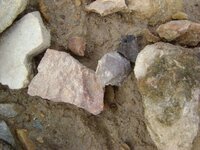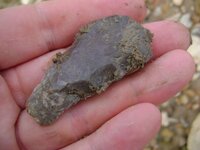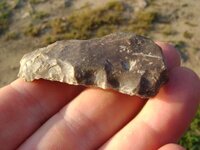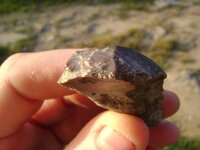uniface
Silver Member
Thirty7 and I have been working on identifying an interesting tool variety that turns up (so far) in southern W. Virginia (where he's found three), Kentucky and western Tennessee. The shape of it is consistent from example to example, and puts it in the Early Archaic era (atypical of Paleo analogues, and recognisable from other, published examples).
These seem to start as narrow outrepasse flakes with the terminal hook edge retouched as endscrapers (par for the course) and knife-edge retouch on the sides (also normal on early stuff). This one (and the green-grey and reddish chert example thirty7 posted a few days ago) are left in this state. On two examples (one he drew with the title "Black Beauty" I hung on it) and a similar one he has are further modified by having had a tranchet flake driven across most of the distal (scraper) edge, producing a square-edged backing for using the knife edge at top left pretty vigorously. (In the BB example, so vigorously that the edge itself was pressure-flaked off). Another he posted has the entire distal edge taken off this way.
Bopping around the 'net, I turned up an illustration of a similar one from the Taylor Site. As we expected (from what he was finding along with them), they are associated with Early Side Notched points and Dalton points with deep basal concavities.
These seem to start as narrow outrepasse flakes with the terminal hook edge retouched as endscrapers (par for the course) and knife-edge retouch on the sides (also normal on early stuff). This one (and the green-grey and reddish chert example thirty7 posted a few days ago) are left in this state. On two examples (one he drew with the title "Black Beauty" I hung on it) and a similar one he has are further modified by having had a tranchet flake driven across most of the distal (scraper) edge, producing a square-edged backing for using the knife edge at top left pretty vigorously. (In the BB example, so vigorously that the edge itself was pressure-flaked off). Another he posted has the entire distal edge taken off this way.
Bopping around the 'net, I turned up an illustration of a similar one from the Taylor Site. As we expected (from what he was finding along with them), they are associated with Early Side Notched points and Dalton points with deep basal concavities.
Attachments
Upvote
0


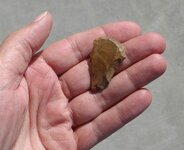

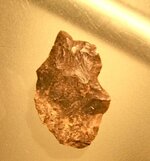
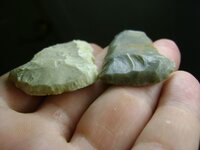
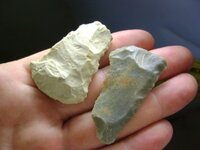
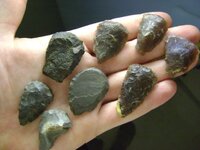
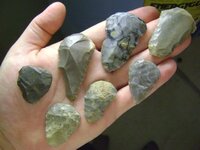

 Nice collection thirty7.
Nice collection thirty7.